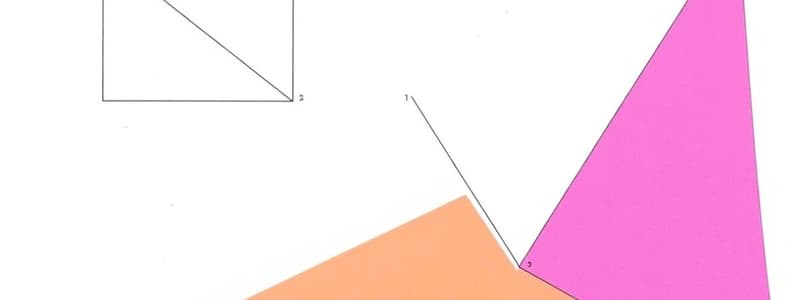Podcast
Questions and Answers
In an isosceles trapezoid $ABCD$, where $AB$ and $CD$ are the bases, which of the following statements is NOT necessarily true?
In an isosceles trapezoid $ABCD$, where $AB$ and $CD$ are the bases, which of the following statements is NOT necessarily true?
- The diagonals $AC$ and $BD$ are congruent.
- Angles $∠ABC$ and $∠BAD$ are congruent.
- Angles $∠ADC$ and $∠BCD$ are congruent.
- Angles $∠ABC$ and $∠BCD$ are supplementary. (correct)
Given a kite $EFGH$ where $EG$ is the longer diagonal and $FH$ is the shorter diagonal. If $∠FEH = 50°$, what is the measure of $∠FGH$?
Given a kite $EFGH$ where $EG$ is the longer diagonal and $FH$ is the shorter diagonal. If $∠FEH = 50°$, what is the measure of $∠FGH$?
- 50° (correct)
- Cannot be determined without additional information.
- 130°
- 80°
A trapezoid has bases of length 10 and 14. What is the length of its median?
A trapezoid has bases of length 10 and 14. What is the length of its median?
- 24
- 14
- 10
- 12 (correct)
Quadrilateral $PQRS$ has diagonals that are perpendicular bisectors of each other. Which of the following classifications is $PQRS$ guaranteed to be?
Quadrilateral $PQRS$ has diagonals that are perpendicular bisectors of each other. Which of the following classifications is $PQRS$ guaranteed to be?
Two similar triangles, $ΔABC$ and $ΔDEF$, have corresponding sides $AB = 6$ and $DE = 9$. If the area of $ΔABC$ is 24 square units, what is the area of $ΔDEF$?
Two similar triangles, $ΔABC$ and $ΔDEF$, have corresponding sides $AB = 6$ and $DE = 9$. If the area of $ΔABC$ is 24 square units, what is the area of $ΔDEF$?
In parallelogram $ABCD$, diagonals $AC$ and $BD$ intersect at point $E$. If $AE = 3x + 2$ and $EC = 7x - 6$, what is the length of $AC$?
In parallelogram $ABCD$, diagonals $AC$ and $BD$ intersect at point $E$. If $AE = 3x + 2$ and $EC = 7x - 6$, what is the length of $AC$?
Which of the following conditions is sufficient to prove that a quadrilateral is a parallelogram?
Which of the following conditions is sufficient to prove that a quadrilateral is a parallelogram?
In rectangle $PQRS$, $PR = 5x - 3$ and $QS = 3x + 5$. What is the length of $PR$?
In rectangle $PQRS$, $PR = 5x - 3$ and $QS = 3x + 5$. What is the length of $PR$?
Which property is unique to rhombuses compared to all other parallelograms?
Which property is unique to rhombuses compared to all other parallelograms?
In rhombus $WXYZ$, if $\angle WXY = 60^{\circ}$, what is the measure of $\angle WZY$?
In rhombus $WXYZ$, if $\angle WXY = 60^{\circ}$, what is the measure of $\angle WZY$?
Three lines intersect at the same point. What is this configuration called?
Three lines intersect at the same point. What is this configuration called?
If the consecutive angles of a quadrilateral are supplementary, which type of quadrilateral can it be definitively classified as?
If the consecutive angles of a quadrilateral are supplementary, which type of quadrilateral can it be definitively classified as?
Which of the following statements is always true for a square?
Which of the following statements is always true for a square?
Flashcards
Properties of a square
Properties of a square
All angles are right; diagonals bisect and are congruent.
Median of a trapezoid
Median of a trapezoid
A segment joining midpoints of non-parallel sides, half the sum of the bases.
Isosceles trapezoid
Isosceles trapezoid
A trapezoid with congruent legs and base angles; diagonals are also congruent.
Properties of a kite
Properties of a kite
Signup and view all the flashcards
Similar figures
Similar figures
Signup and view all the flashcards
Parallelogram
Parallelogram
Signup and view all the flashcards
Properties of Parallelograms
Properties of Parallelograms
Signup and view all the flashcards
Conditions for Parallelogram
Conditions for Parallelogram
Signup and view all the flashcards
Rectangle
Rectangle
Signup and view all the flashcards
Rhombus
Rhombus
Signup and view all the flashcards
Square
Square
Signup and view all the flashcards
Diagonals of Parallelogram
Diagonals of Parallelogram
Signup and view all the flashcards
Supplementary Angles
Supplementary Angles
Signup and view all the flashcards
Study Notes
Parallelograms
- Parallelograms are quadrilaterals with opposite sides parallel.
- Intersecting lines share a common point.
- Concurrent lines share a common point.
- Perpendicular lines intersect at a right angle.
- Transversal lines intersect two or more lines at distinct points.
Properties of Parallelograms
- Opposite sides are parallel and congruent.
- Opposite angles are congruent.
- Consecutive angles are supplementary (add up to 180 degrees).
- Diagonals bisect each other.
- Each diagonal divides the parallelogram into two congruent triangles.
Conditions for a Quadrilateral to be a Parallelogram
- Condition 1: If both pairs of opposite sides are congruent, then the quadrilateral is a parallelogram.
- Condition 2: If one pair of opposite sides is congruent and parallel, then the quadrilateral is a parallelogram.
- Condition 3: If both pairs of opposite angles are congruent, then the quadrilateral is a parallelogram.
- Condition 4: If consecutive angles are supplementary, then the quadrilateral is a parallelogram.
- Condition 5: If the diagonals bisect each other, then the quadrilateral is a parallelogram.
- Condition 6: If each diagonal forms two congruent triangles, then the quadrilateral is a parallelogram.
Rectangles
- A parallelogram with four right angles.
- Equiangular but not necessarily equilateral.
- Opposite sides are parallel and congruent.
- All angles are congruent and are right angles.
- Consecutive angles are supplementary.
- Diagonals bisect each other and are congruent.
- Each diagonal divides the rectangle into two congruent triangles.
Rhombus
- A quadrilateral with four congruent sides.
- Equiangular but not equilateral.
- Opposite sides are parallel and congruent.
- All sides are congruent.
- Opposite angles are congruent.
- Consecutive angles are supplementary.
- Each diagonal bisects a pair of opposite angles.
- Each diagonal is a perpendicular bisector of the other diagonal.
- Each diagonal divides the rhombus into two congruent triangles.
- The diagonals of a rhombus are perpendicular.
Square
- A quadrilateral with four congruent sides and four congruent angles (right angles).
- All sides are parallel and congruent.
- All sides are congruent.
- All angles are congruent and are right angles.
- Opposite angles are congruent and supplementary.
- Consecutive angles are supplementary and congruent.
- Diagonals are congruent and bisect opposite angles.
- Each diagonal is a perpendicular bisector of the other diagonal.
- Each diagonal divides the square into two congruent triangles.
Trapezoid
- A quadrilateral with exactly one pair of parallel sides.
- The parallel sides are called bases.
- The non-parallel sides are called legs.
- The median of a trapezoid is a segment connecting the midpoints of the legs. It's parallel to the bases and its length is half the sum of the lengths of the bases.
- Isosceles Trapezoid: A trapezoid in which the legs are congruent. Base angles are congruent and diagonals are congruent.
Kite
- A quadrilateral with two distinct pairs of consecutive congruent sides.
- Only one pair of opposite angles is congruent.
- One diagonal bisects the other.
- The diagonals are perpendicular.
- The area of a kite is half the product of the lengths of its diagonals.
Similar Figures
- Figures with the same shape but not necessarily the same size.
- Corresponding sides are proportional.
- Corresponding angles are congruent.
Congruent Figures
- Figures with the same shape and size.
- Corresponding sides and angles are congruent.
Basic Proportionality Theorem (BPT)
- If a line is drawn parallel to one side of a triangle and intersects the other two sides in distinct points, then it divides the sides proportionally.
Right Triangle Similarity Theorem
- If the altitude is drawn to the hypotenuse of a right triangle, then the two triangles formed are similar to each other and to the original right triangle.
Geometric Mean Theorem
- In a right triangle, the altitude to the hypotenuse divides the hypotenuse in two segments, and the altitude is the geometric mean of the segments. The length of a leg is the geometric mean of the hypotenuse and the adjacent segment.
Special Right Triangles
- 45-45-90 Triangles: The hypotenuse is √2 times the length of a leg.
- 30-60-90 Triangles: The hypotenuse is twice the length of the shorter leg, and the longer leg is √3 times the shorter leg.
Studying That Suits You
Use AI to generate personalized quizzes and flashcards to suit your learning preferences.




